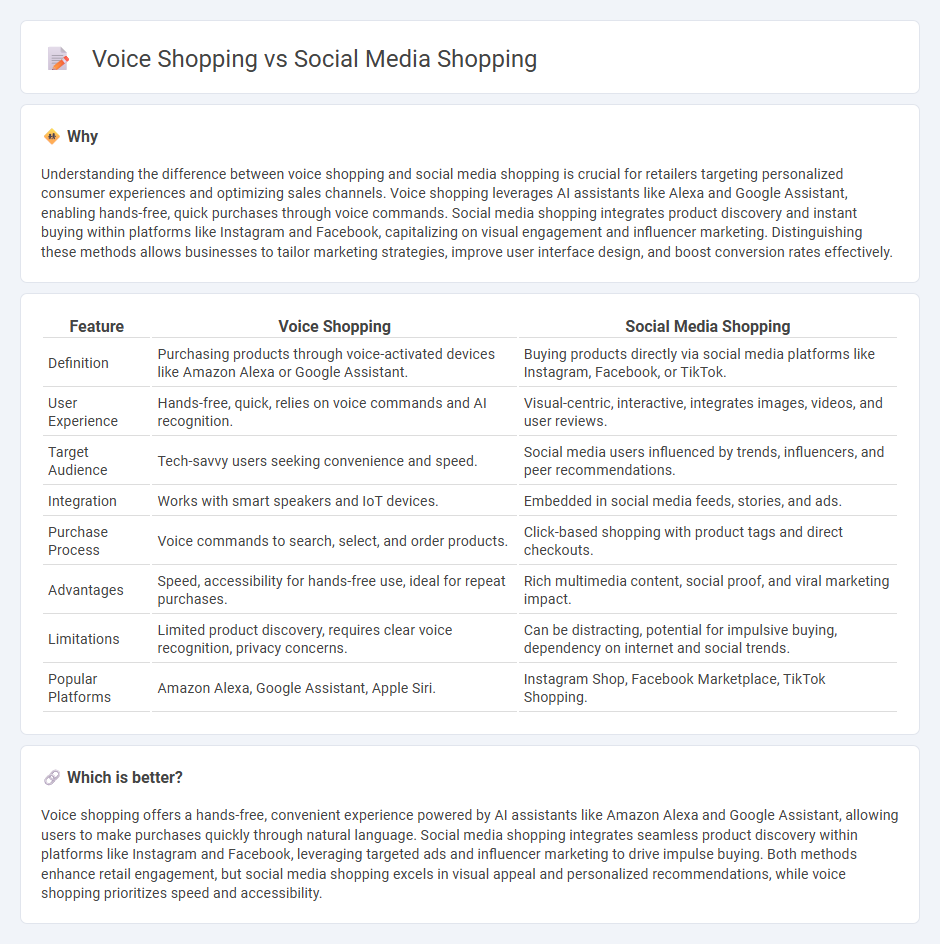
Voice shopping leverages AI-driven virtual assistants like Amazon Alexa and Google Assistant to provide hands-free, convenient purchasing experiences through voice commands. Social media shopping integrates e-commerce directly into platforms such as Instagram, Facebook, and TikTok, enabling users to discover and buy products seamlessly within social feeds. Explore the evolving dynamics of retail by understanding how voice shopping and social media shopping are reshaping consumer behavior.
Why it is important
Understanding the difference between voice shopping and social media shopping is crucial for retailers targeting personalized consumer experiences and optimizing sales channels. Voice shopping leverages AI assistants like Alexa and Google Assistant, enabling hands-free, quick purchases through voice commands. Social media shopping integrates product discovery and instant buying within platforms like Instagram and Facebook, capitalizing on visual engagement and influencer marketing. Distinguishing these methods allows businesses to tailor marketing strategies, improve user interface design, and boost conversion rates effectively.
Comparison Table
| Feature | Voice Shopping | Social Media Shopping |
|---|---|---|
| Definition | Purchasing products through voice-activated devices like Amazon Alexa or Google Assistant. | Buying products directly via social media platforms like Instagram, Facebook, or TikTok. |
| User Experience | Hands-free, quick, relies on voice commands and AI recognition. | Visual-centric, interactive, integrates images, videos, and user reviews. |
| Target Audience | Tech-savvy users seeking convenience and speed. | Social media users influenced by trends, influencers, and peer recommendations. |
| Integration | Works with smart speakers and IoT devices. | Embedded in social media feeds, stories, and ads. |
| Purchase Process | Voice commands to search, select, and order products. | Click-based shopping with product tags and direct checkouts. |
| Advantages | Speed, accessibility for hands-free use, ideal for repeat purchases. | Rich multimedia content, social proof, and viral marketing impact. |
| Limitations | Limited product discovery, requires clear voice recognition, privacy concerns. | Can be distracting, potential for impulsive buying, dependency on internet and social trends. |
| Popular Platforms | Amazon Alexa, Google Assistant, Apple Siri. | Instagram Shop, Facebook Marketplace, TikTok Shopping. |
Which is better?
Voice shopping offers a hands-free, convenient experience powered by AI assistants like Amazon Alexa and Google Assistant, allowing users to make purchases quickly through natural language. Social media shopping integrates seamless product discovery within platforms like Instagram and Facebook, leveraging targeted ads and influencer marketing to drive impulse buying. Both methods enhance retail engagement, but social media shopping excels in visual appeal and personalized recommendations, while voice shopping prioritizes speed and accessibility.
Connection
Voice shopping leverages AI-powered virtual assistants like Amazon Alexa and Google Assistant to enable hands-free product searches and purchases, streamlining the retail experience. Social media shopping platforms such as Instagram and Facebook integrate voice recognition technology to enhance user interaction, allowing consumers to make instant purchases through voice commands while browsing. This convergence of voice shopping and social media shopping drives higher engagement, personalized recommendations, and faster transaction processes in the retail sector.
Key Terms
Influencer Marketing
Influencer marketing significantly boosts social media shopping by leveraging content creators to promote products directly within engaging posts, stories, and live streams, generating immediate consumer trust and interaction. In voice shopping, influencer impact is less direct but growing, with voice assistants enabling subtle brand mentions and personalized recommendations that enhance user experience. Explore the evolving synergy between influencer marketing and these shopping platforms to understand their distinct advantages.
Conversational Commerce
Social media shopping integrates product discovery and purchase within platforms like Instagram and Facebook, leveraging visual content and user interactions to drive sales through conversational commerce tools such as chatbots and direct messaging. Voice shopping, powered by AI assistants like Amazon Alexa and Google Assistant, enables hands-free, seamless purchasing experiences through natural language commands, enhancing convenience and accessibility. Explore the evolving landscape of conversational commerce to understand how these channels transform consumer behavior and boost e-commerce growth.
Shoppable Posts
Shoppable posts on social media platforms integrate e-commerce directly within user feeds, enabling seamless product discovery and instant purchases without leaving the app. Voice shopping leverages voice-activated assistants to simplify purchasing through spoken commands, emphasizing convenience and hands-free interaction. Explore how these distinct approaches transform consumer engagement and drive sales in the digital marketplace.
Source and External Links
What is Social Shopping? The New Trend in Online Shopping - Social shopping integrates social media platforms like Instagram and Pinterest with ecommerce, allowing users to buy products seamlessly through shoppable posts and tags within their social feeds, enhancing the overall shopping experience without leaving the app.
Top 7 Social Shopping Platforms: Revolutionizing Online Retail - Leading social shopping platforms such as Instagram Shopping, Facebook Shops, and TikTok Shopping provide brands with tools like in-app product showcases, influencer collaborations, and customizable storefronts to create engaging, seamless shopping experiences within social media apps.
The Good, the Bad and the Ugly of Shopping on Social Media - Social shopping offers convenience, personalized recommendations, and social interaction by enabling users to discover and purchase products directly from social media timelines, although challenges remain in areas like trust and user experience.
 dowidth.com
dowidth.com